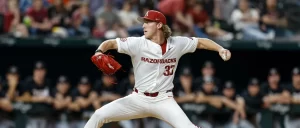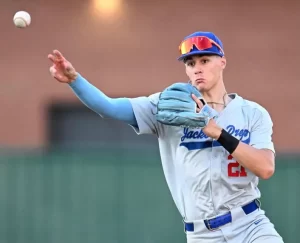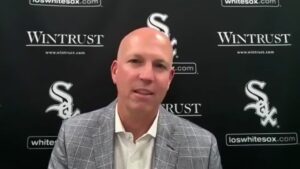2018 MLB Draft Primer
The 2018 First Year Player Draft will begin on Monday June 4th and the White Sox hold the #4 pick in round one (and every full round after). That first night will cover rounds one and two, the second night rounds three through ten, then the third and final day is the speed round as teams hustle through the 900 picks in rounds 11 through 40 within about five hours.
It’s impossible to fully grade a draft until at least three years after it concludes and Director of Amateur Scouting Nick Hostetler is embarking on his third go-around with the keys in his hand. In 2016, Hostetler selected Catcher Zack Collins and RHP Zack Burdi with his first two selections in his current role. Collins is at Double-A Birmingham and is the 5th ranked prospect in the system. Burdi was on a quick path to the majors before that was diverted with a torn Ulnar Collateral Ligament and subsequent surgery. The former Louisville product is currently rehabbing and we should see him back in action later this year. He still profiles as a high-impact back end relief option and is the 14th ranked prospect in the system.
In 2017, the White Sox chose Missouri State 3rd Baseman Jake Burger with the 11th pick in the first round. His leadership qualities were on display this spring prior to suffering a torn Achilles Tendon in a spring training contest. Burger will miss this entire season but should be back at full health to start next year. On our pre-season top 30 list, Burger ranked as the #8 prospect in the organization. While it is too early to make any grand proclamations about either draft, the White Sox earned plaudits locally and nationally in both years from evaluators. At one point in the not too distant past, the White Sox were a club that ignored some broader baseball skills and instead opted for athletes short on tools. That has seemingly changed with the last two drafts focused primarily on college performers with substantial track records.
We will be covering the 2018 MLB Amateur Draft over the next month here at FutureSox. Later this week, Brian Bilek will release a cheat sheet with some names that the White Sox could be interested in with their first pick. We will also roll out our first Prospect Profile with a detailed report on Oregon State infielder Nick Madrigal, to be followed by profiles of other likely 1st round selections throughout the next month. And of course this all culminates in our coverage of the draft itself, where we are the go-to source for White Sox draft reporting. Before all that though, it’s important to know some information about the draft process and how the slotting of bonus pools works for the clubs.

Draft Rules
Each pick in the top 10 rounds of the amateur draft is assigned a pick value by major league baseball, and this year’s slots are now available. According to Jim Callis at mlbpipeline.com, draft slots are 4.2% higher than they were last year. Seven teams have eight-figure bonus pools and the total pool amount for all 30 teams is $255,969,600. $125,000 per player is a “soft cap” for prospects drafted in rounds 11-40 – any bonus amount greater than $125K for those rounds will count against a team’s original draft pool. We will get to the White Sox’ specific slot and pool values shortly.
The days of clubs going way over the draft pool to sign high upside talent have proven to be over. The penalties for doing so are just too excessive. If a club outspends its pool amount by 0-5 percent, they will be required to pay a 75% tax on the overage amount (the White Sox did this in 2014 to nab Carlos Rodon). Going over by 5-10 percent requires a forfeiture of a first round pick in addition to the 75% overage. The penalties for going over in the 10-15 percent range require the forfeiture of first and second round choices along with paying an overage of 100%. Any club that spends over 15% more than their allotted total will forfeit two first rounders and pay the 100% overage tax. The bonus pool system has been in place since 2012 and no team has gone more than 5% over the total pool in that time. Teams are not willing to forfeit picks and the penalties have proven to be substantial.
Cincinnati Reds RHP prospect Hunter Greene signed for $7.23 million last year and that is the largest bonus handed out under the new system. The Chicago White Sox have a total pool of $10,589,900. They have the 7th highest bonus pool this year while picking 4th in every round. The Kansas City Royals ($12,781,900), Tampa Bay Rays ($12,415,600), Detroit Tigers ($12,414,800), San Francisco Giants ($11,747,500), Cincinnati Reds ($10,900,400), and Pittsburgh Pirates ($10,390,400) have the 6 highest bonus allotments in the draft. The Royals, Rays, Reds and Pirates have the luxury of possessing competitive balance picks that greatly enhance their bonus total.
White Sox Bonus Amounts for Top 10 Rounds
- Round 1 Pick 4: $6,411,400
- Round 2 Pick 46: $1,556,100
- Round 3 Pick 81: $726,700
- Round 4 Pick 108: $517,800
- Round 5 Pick 138: $386,800
- Round 6 Pick 168: $290,200
- Round 7 Pick 198: $226,200
- Round 8 Pick 228: $179,200
- Round 9 Pick 258: $153,200
- Round 10 Pick 288: $142,300
Individually, the bonus amounts are just recommendations for the particular slot and clubs decide which is the best way to maneuver and get as many good players as possible. Together they add up to the team’s total pool amount for all top ten round bonuses plus any of those Rounds 11-40 overages. It’s extremely unlikely that a club would select one player in each round and pay that specific player the amount recommended by Major League Baseball. Some teams spend a lot on the first couple of picks and go under with later picks while other clubs cut deals with players in earlier rounds in order to allocate more money in the mid to late rounds of the draft.
Last year, the White Sox went slightly under-slot with Burger in the 1st round and went over-slot with a $2 million bonus for Gavin Sheets in round 2. It is a general rule that all or nearly all of the players drafted with a pick in the top 10 rounds will sign a professional contract. It’s imperative to get those players signed due to the forfeiture of the bonus amount as the alternative. For example, if the White Sox failed to sign their 3rd round draft pick, they would also lose the right to spend the $726,700 associated with the 81st overall pick. If chances are being taken on players with signability concerns, it is likely done during rounds 11-40.
Many teams in recent years have opted to go for a player that wasn’t necessarily a consensus pick very high in the draft in order to re-allocate some pool money for later in the draft. The Twins selected high school phenom Royce Lewis last year with some prodigious college talent on the board and then turned around and spent money throughout the entire draft. This has been a popular strategy of late but things could be different this year. Most of the teams that have decided to take this approach are blessed with extra picks in the draft and the opportunity has been there to try to “push” talented players down to a later pick. This year, the Tigers, Giants, Phillies, and White Sox occupy the top four slots in the draft and as big market clubs, none of them receive the full benefits of rebuilding that smaller market organizations do.
Hostetler has taken a bit of a media tour of late and he has continued to emphasize the fact that regardless of who the White Sox take in the first round, we should assume that the player in question was rated as the highest on their board. Hostetler told James Fegan of The Athletic that it would be unlikely for the club to go over-slot at #4. He also told David Wildman of The Loop Sports that they are primarily looking at a cloud of 7-8 players with their first pick. There has been a lot of talk about the White Sox targeting high school players in order to better balance the farm system that they currently have. Hostetler hasn’t completely scoffed at the notion but he has mentioned numerous times that he will focus on the best player early on and maybe look to acquire system needs on the draft’s third day. The ultimate goal of course is to complete the best overall draft possible, so be careful jumping to conclusions based on day one of the three-day frenzy.
It is officially draft season and in about 4 short weeks the White Sox will be on the clock.
Want to know right away when we publish a new article? Type your email address in the box on the right-side bar (or at the bottom, if on a mobile device) and click the “create subscription” button. Our list is completely spam free, and you can opt out at any time.







